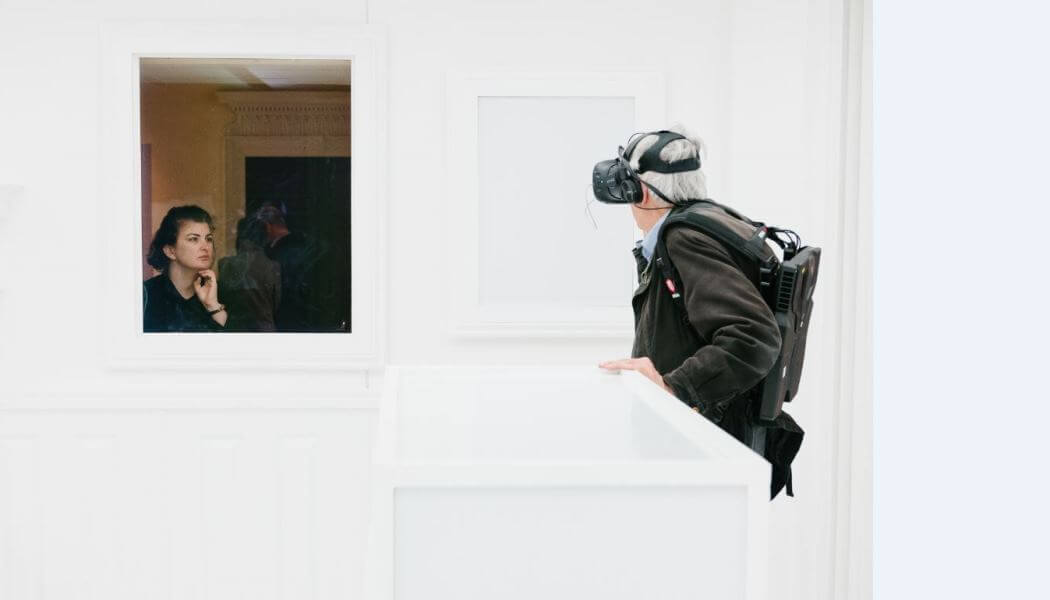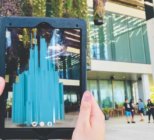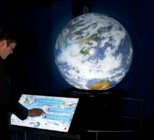To someone peering into the white box that is Thresholds and seeing people wearing goggles and backpacks, walking around white painted display cases – appearing to pick objects up and examine them (when nothing is actually there) – the whole thing looks surreal and slightly barmy.
However, it’s not quite as crazy as it seems, as visitors to Thresholds are experiencing ‘a fully immersive portal to the past and are walking through the digitally reconstructed room of the Fox Talbot exhibition’, which took place almost 180 years ago. They are able to experience the grandeur of the old building, the layout of the exhibition, touch objects in the bespoke vitrines and feel the heat of a coal fire, all to the soundtrack of the Chartist rioters seen through virtual windows. Infrared sensors track visitors’ movements and indicate their position, so as to avoid collisions, as they discover Fox Talbot’s breakthroughs in photographic imagery.
This was an opportunity to use this image-based technology, virtual reality, to go back to the birth of all image-based technologies, photography
The VR exhibition was conceived and devised by artist Mat Collishaw in September 2015 as he was looking for a project to work on in this new medium. As he was being shown through the extensive photographic archive at the Library of Birmingham by independent photographic historian and curator, Pete James, who was at the time Curator of Photography Collections at the library, the latter suggested that the Fox Talbot exhibition could be the perfect subject matter. The original exhibition had taken place nearby in the now demolished King Edward’s School on New Street, built four years earlier by Charles Barry, and was the venue for the 9th Annual Meeting of the British Association for the Advancement of Science in August 1839.
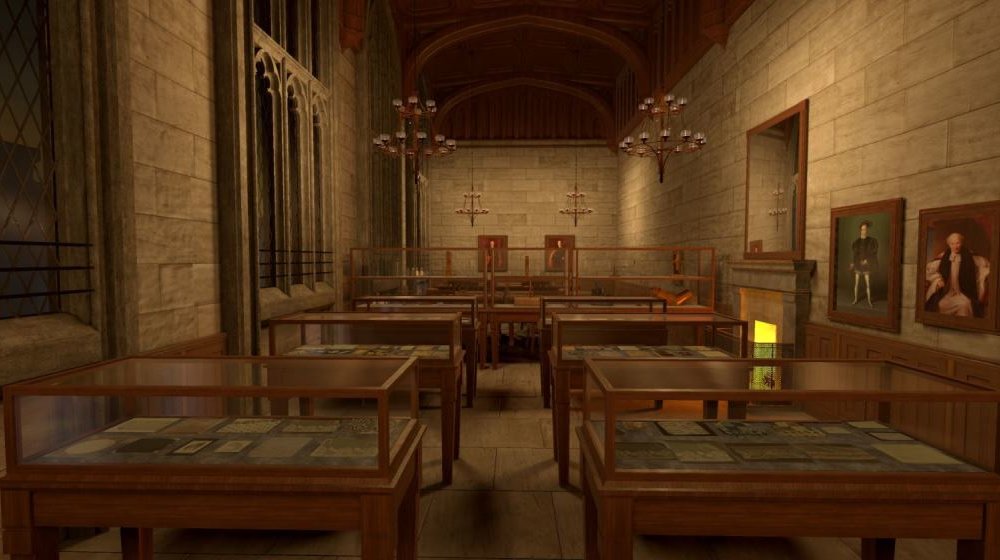
“I’d been looking around for a subject for VR for years and wanted to have a subject that was somehow pertinent to the way we see the world through a mediated image,” says Collishaw. “And this was an opportunity to use this image-based technology, virtual reality, to go back to the birth of all image-based technologies, photography. So, you are visiting the birth of a medium that spawned all other image-based technologies that came after it. And this has been achieved using the latest image-based technology.”
Following 20 months of off-and-on research and design, the exhibition opened at Somerset House in May 2017 in conjunction with Photo London and has since travelled to the Waterhall Gallery at Birmingham Museum and Art Gallery between June and August, the National Trust’s Lacock Abbey, in Wiltshire (once home to Fox Talbot and now housing a museum in his name) between September and October and will travel to the National Science and Media Museum in Bradford in March before moving to Istanbul in the summer and the Bodleian Library, Oxford later in the year.
“I wanted to use VR because I make art that a lot of the time is to do with how we see the world through the mediated image. And VR’s the latest tech, it’s the latest thing we have of making a simulation of the world and it is a significant step in that evolution because with 360º simulation it’s unlike any medium that’s gone before.”
The technology was used to bring to life the research and sources that Collishaw had collected including insight into the building and the contents of the exhibition, which consisted of 93 images that were intended to demonstrate the versatility and potential applications of Fox Talbot’s revolutionary photographic discovery – to make images paper-coated with silver nitrate that darkened upon exposure to light – made public in January 1839.
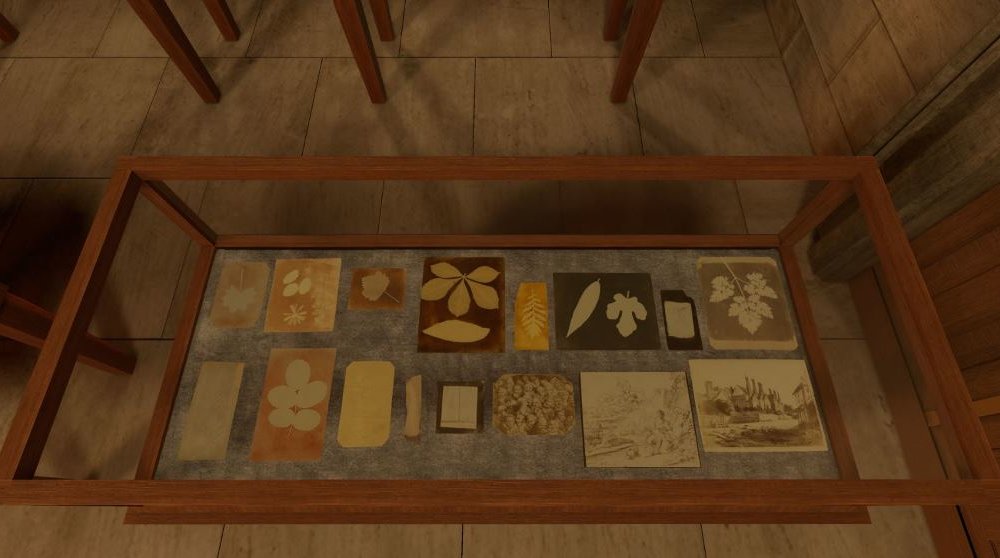
“We had a list of 93 photographs that were located around the world, which took months of research to find out where they were, get permission to use them and then make quality scans of them to be included in the vitrines.” Many were at Bradford National Science and Media Museum and the Bodleian Library in Oxford and others at the V&A, Art Institute of Chicago and the Met in New York. And for the actual interior of the room, Collishaw visited the collection at King Edward’s School, Edgbaston, which was built as a replacement for the school on New Street.
Collishaw also contacted an architectural historian who is a world expert on Charles Barry and who offered advice in terms of what kind of stone and wood was used in the building and the lighting they would have used at the time.

Once Collishaw had all the information he needed he began working with a number of experts in different fields to realise his vision including Dr Paul Tennent, a research fellow at the University of Nottingham’s mixed reality laboratory, who researched the project as part of his PhD research. Tennent also developed the movement detection side of the project and how the computers would work in controlling the whole experience. Collishaw also worked with VMI, a company that creates CGI interiors mainly for new buildings and interfaces it with VR. As well as with fabrication company, Whitewall, who make sculptures to build the actual room based on the plans that were made with VMI.
The headsets used for the exhibition were manufactured by HTC Vive and Thresholds was the first UK museum-style exhibition to work with the technology. Since then two exhibitions have launched in London that use the same headsets: Modigliani at Tate Modern, which runs until April 2018 and From Life at the Royal Academy of Arts, which runs until March 2018.
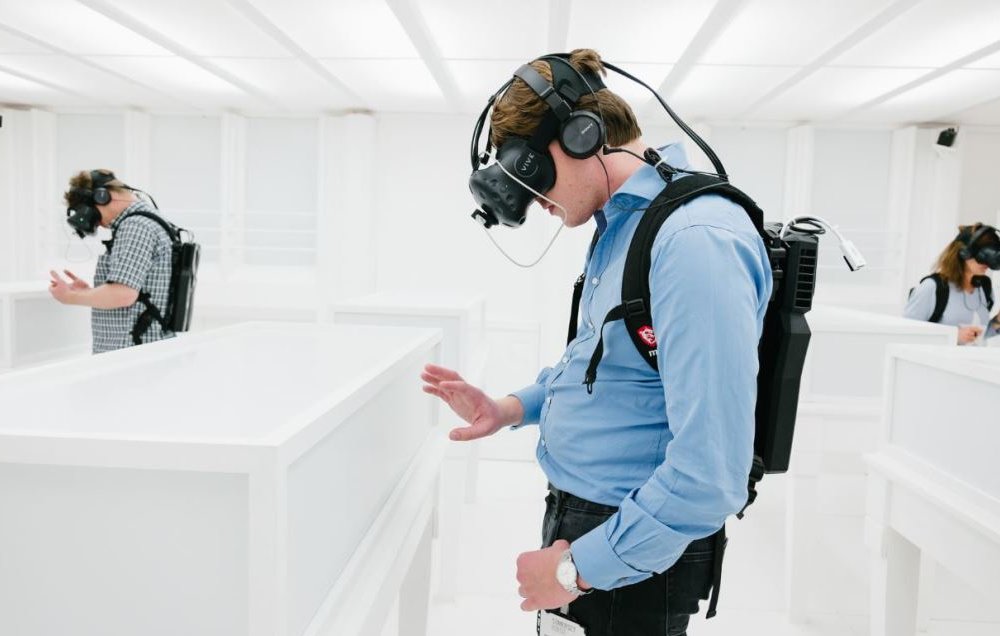
HTC gave the artist technical support and lent him ten headsets for the first leg of the tour at Somerset House. But following that he had to buy the headsets for the subsequent tours.
The HTC Vive is currently the most advanced virtual reality technology available globally, offering thousands of different experiences across gaming, arts, health and fitness, medicine, film and theatre, retail and healthcare. Each headset had to be connected to a computer from MSI, which people wear as a backpack and gives them the ability to wonder around freely without being connected to a cable from the ceiling.
As well as research and development, Collishaw managed the timed ticket bookings, the visitor flow and the maintenance of the technology. “It was a steep learning curve and the nearest thing I’ve seen to this project is by a company called THE VOID who are in Salt Lake City, which has a huge team so for me as an individual taking this on was madness.”
To get the project off the ground Collishaw launched a Kickstarter campaign and raised £25,000. Thresholds was then presented in collaboration with Collishaw’s gallery Blain|Southern and supported by Colmore Business District, Birmingham City University, King Edward’s School, The Schools of King Edward’s Birmingham, BOM (Birmingham Open Media), an Art Fund Jonathan Ruffer Curatorial Grant, the exhibition’s touring partners and personal investment from the artist.
Collishaw says the visitor response has been overwhelmingly positive: “People go in there, experience it and come out and go wow that was really amazing, ‘can we do it again?’ There is a big reward for me knowing that people are really quite thrilled to experience it. There are also people that are not in the tech demographic such as the older generation who have been quite sceptical at first but when they come out they say how respectful it is to history. So it was great to get a whole range of responses including those from young kids who might be a bit board going to an art gallery to older people suspicious of technology. The pay off in terms of response has been very good and very positive.”
Collishaw is continuing discussions with other potential cultural organisations to continue the tour and is also producing a book to be published in May for the exhibition in Istanbul, which he says will visualise the whole arc of the project. Collishaw says he is also working on a project that uses technology in a way that he hasn’t used it before at Queen’s House in Greenwich, which we think will be worth keeping an eye on.
The Historian's View - Pete James
Pete James is an independent photographic historian and curator and former Curator of Photography Collections at the Library of Birmingham, who helped Collishaw create Thresholds. James also curated a complimentary exhibition of archival and contemporary material which included Talbot facsimile prints, architectural drawings and a copy of the 1839 exhibition catalogue as well as Cornelia Parker’s Fox Talbots Articles of Glass around the VR/ AR installation, placing traditional museum presentation and future digital presentation display strategies in there same space.
“I’m interested in the history of photography and Talbot’s 1839 show was undoubtedly a key moment in local and national photographic history. It was the largest public exhibition of his work that he ever assembled and no-one had done any really detailed research into the location and context of it being in Birmingham. I had begun to think about somehow recreating Talbot’s show in Birmingham a couple of years before using facsimile prints, but it would have been just a dull, traditional gallery display with surrogates and interpretive material. When Mat and I met and talked there was a collision of ideas – Mat’s desire to do a VR project and mine to do the Talbot show. It was the perfect solution for both of us.
It was an experience in which architecture, historical artefacts, social history and the history of technologies were brought together in a physical space. It was commentary on the history of technologies and the power of images to transform and shape our understanding of the world.
AR/VR provided the opportunity to make the exhibition a physical, optical, tactile and emotional journey through a kind of time loop between past and present. It enabled us to create a kind of parallel sense of wonder between those seeing photography for the first time in 1839 and newcomers to the VR/AR technology in 2017.
AR/VR certainly has a key role to play in the future of museums. Although not cheap, they have the potential to make it easier to reach wide audiences through multiple, simultaneous, and remote experiences of an exhibition which enable them to experience artefacts, ideas and context in a revolutionary way.”
Upcoming dates for Threshold
National Science and Media Museum, Bradford, 2 March – 7 May 2018
Yapi Kredi Kültür Sanat Yayincilik A.S. Istanbul, 15 May – 28 July 2018
The Bodleian Library, Oxford (dates tbc)
VR Equipment
This case study is part of an In Focus feature on Technology in Museums

